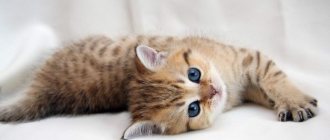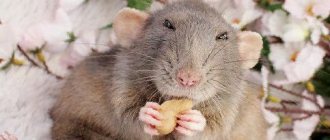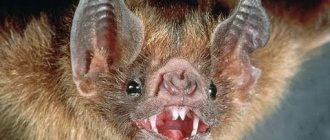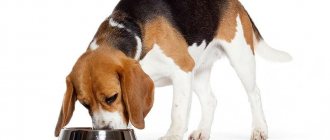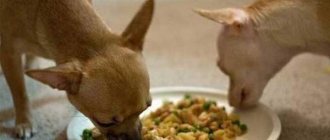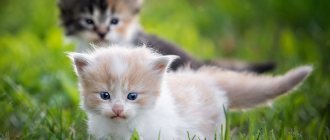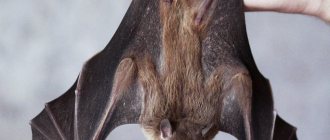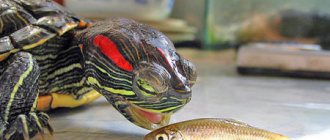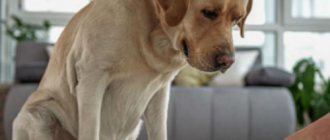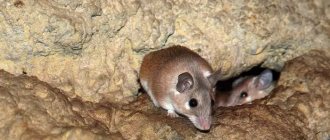It is traditionally believed that mice are omnivores. Many people know them as terrible gluttons who eat no less than 20% of all products that people produce.
For many centuries, poor mice were not loved for this. But today, good owners are wondering whether mice are really omnivorous, and how to feed the rodent correctly . Let's try to figure it out together.
When buying a decorative mouse, do not flatter yourself with the hope that you can feed it with scraps from your table.
Such a treat can cause unpleasant illnesses for your pet, since excess salt is not recommended for mice, and spices are completely contraindicated.
What to feed a rodent at home? There's no need to reinvent the wheel. The best option is balanced food for rodents, which is easy to find in any pet store today.
What do mice eat?
Animals belong to the order of rodents; the structure of the teeth and intestinal tract of the animal determines its diet. Mice are unpretentious and omnivorous; they can eat a variety of plant and animal foods. The peculiarity of the intestines does not allow them to fully absorb nutrients. Wild mice, constantly moving, require daily amounts of food comparable to their own weight.
Keeping a decorative mouse at home
Nutrition of mice in natural conditions
The favorite foods of rodents in the summer are grains and root vegetables. Mice cause significant damage to agriculture. Animals are voracious: they eat vegetables and fruits, seeds of trees (maple, beech) and plants (clover, fescue), and mushroom caps.
Rodents feed on small invertebrate animals. What do mice eat most often?
- grasshoppers;
- slugs;
- earthworms;
- spiders;
- crickets.
What do mice eat in winter in nature?
The animals create reserves for the cold season. They store food in secluded places underground, natural shelters, and in leaf litter. When there is a lack of food, mice gnaw at the roots of plants and eat the bark of trees. With the onset of frost, wild mice try to penetrate cellars and storages of vegetables and grain.
Interesting! Hungry rodents can eat wood and paper.
Where to buy a decorative mouse
If you decide to get your own little mouse, don’t rush to set traps in your dacha in the hope that you’ll catch your mouse this way. You may catch it, but this mouse will not be intended for home use. It would be better for you to choose a mouse in a special nursery (there are also those that specialize in breeding decorative mice) or at an exhibition. If you buy a mouse from your own hands or from a pet store, there is a high probability that the animal may be infected with worms or other parasites.
As for the number of decorative mice you purchase, if you get a female, you can choose another female for her company - the rodents will enjoy being in the company, and they will be friends. But, if you add another male to the male, then you cannot do without bloodshed. But the cohabitation of a female and a male will inevitably end in numerous offspring.
It is better to transport mice home in a special box or in a box with holes for ventilation.
Diet of mice in captivity
What do ferrets eat in the wild and at home - food list
When keeping an animal as a pet, it is necessary to provide the rodent with a balanced diet, which will ensure that the body receives proteins, fats and carbohydrates in sufficient quantities. A diet containing the necessary minerals and vitamins has a beneficial effect on the condition of the animal’s coat, bone tissue, teeth and claws.
What should you feed your mouse at home?
The easiest way is to purchase specialized feed in the store, available in the “economy” and “premium” classes. The basis of cheap feed is a mixture of wheat, oats, and millet. High-quality ready-made food has a balanced composition, contains valuable plant and animal proteins and fats, and essential microelements. Experts do not recommend feeding rodents exclusively with compound feed. They should be combined with natural products. Vegetables, fruits and herbs rich in fiber are especially important.
Ready-made food for rodents
What do mice eat when creating their own diet:
- various cereals, which it is advisable to give whole;
- root vegetables, vegetables, fruits;
- seeds, nuts; legumes;
- egg white, lard, cheese.
In the spring, lacking vitamins, the mouse willingly eats grass and green vegetables. The diet of young animals and pregnant females should contain more calories: proteins and fats necessary for growth and formation of the skeleton and internal organs.
The diet of a rodent is made up taking into account the following factors:
- daily nutrient requirements depending on the species or breed;
- physiological state (illness, pregnancy, postpartum period);
- pet's age;
- time of year (in summer mice feed more actively).
Important! It is unacceptable to feed your pet table scraps. Salt and spices can negatively affect the health of a rodent.
Mouse health
The health and life expectancy of a domestic mouse depends on the conditions of its maintenance and care. If you choose the right cage location and proper nutrition, the rodent will live a long and happy life. The owner also needs to monitor the behavior and condition of the mouse, responding to the following alarming symptoms:
- apathy and impaired motor activity;
- lack of appetite;
- untidiness of appearance – tousled fur, loss of tufts of fur;
- blood in the urine and discharge from the anus;
- teary eyes.
If you regularly pick up the mouse and examine it, health problems can be noticed in the early stages, therefore, it will be possible to seek professional help in time.
Prevention of mouse diseases is as follows:
- Proper nutrition.
- Compliance with containment conditions.
- Quarantine for new arrivals (for 1-2 weeks with constant monitoring) and sick individuals (the duration depends on the course of the disease).
What can you feed a mouse?
What do Djungarians eat - a list of healthy and harmful foods
In natural conditions, rodents move a lot in search of food, and they are not at risk of obesity. Keeping it at home leads to a sedentary lifestyle for the animal. Feeding should be carried out 2 times a day, the amount of food should be about 20% of the animal’s weight. The exception is the diet of pregnant females, who should be fed 4 times a day.
The mouse consumes a small amount of water; the liquid is formed in the animal’s body during the digestion of food. Despite this, a drinking bowl must be installed in the cage, where the water is replaced with fresh water every 2-3 days.
Cereals are the main food of rodents
What mice like - list of food items:
- Cereals should make up 30-40% of the diet. It is preferable to feed whole grain wheat, oats, millet, and barley.
- The bread is preferably black, in the form of crackers. White bread and buns contribute to the development of obesity.
- Root vegetables - carrots, beets - are offered to the animal every other day, potatoes - no more than 2 times a week.
- Mice love to eat seeds and nuts. However, they should be given once every 2-3 days; these are high-calorie foods.
- Legumes - beans, lentils are allowed to be added to the diet in small quantities 2-3 times a week.
- Fruits - apple, pear once every 3-4 days. In winter, dried fruits in small quantities are useful.
- Hay - contains a large amount of fiber, an essential food in winter to improve digestion. In spring, hay is replaced with sprouted wheat.
- In the summer-autumn period, crushed meadow and forest herbs are introduced into the diet: sweet clover, lupine, nettle, clover, plantain.
- Animal proteins - unsalted lard, chicken fillet, cottage cheese, egg white. Products are given every other day in small quantities.
- Vegetables - broccoli, cauliflower, cucumbers, zucchini - 2 times a week.
- Yeast, bone meal and chalk are periodically added to pet food as mineral supplements.
Many owners are interested in the question: can a mouse eat acorns? This is heavy food, but rodents need oak fruits in small quantities to wear down their teeth.
Acorns are good for teeth
On a note! It is useful for mice to give twigs of apple, hazel, and rowan. Animals need solid food. By chewing the bark, animals train their chewing apparatus. Lilac branches are poisonous to rodents.
What not to give to mice
Rodents love smoked meats, sausages, and fried meat products. This food contains a lot of fat, is harmful to the digestive tract of animals, and causes obesity. Foods that should not be fed to mice:
- chocolate, sweets;
- citrus;
- store-bought food for cats and dogs;
- cabbage, onions, tomatoes - cause bloating;
- herbs containing bitterness - wormwood, celandine;
- Milk can cause indigestion.
Spicy foods containing a lot of salt and spices significantly impair the functioning of the pet’s digestive tract, and in some cases can lead to its death.
What else can you supplement your diet with?
To prevent decorative mice from having problems with teeth grinding down, in addition to the main food, it is advisable for them to occasionally gnaw on pieces of spruce and pine needles, as well as tree branches:
- aspen;
- hazel;
- apple trees;
- and you;
- rowan.
The branches should be young and juicy, with high nutritional and taste properties.
It is advisable to supplement the diet of ornamental rodents with the following products:
- boiled meat (including well-processed spongy bones and cartilage);
- egg powder (or crushed boiled eggshells);
- milk and dairy products;
- cheese (in limited quantities);
- fresh lard;
- mineral additives (chalk, salt);
- fish oil;
- yeast;
- nuts (except peanuts).
Nutritional characteristics of mice depending on breed
What do rats eat at home and in the wild?
The diet of rodent species is similar, but there are some nuances in feeding different breeds of mice. Large animals need 7-15 g of food per day, small species need 5-10 g per day.
Japanese dwarf mouse
Japanese mouse
The size of a small decorative rodent does not exceed 4-6 cm. Animals are fed once a day, the amount of food is 1 tsp. The diet of the Japanese mouse is based on grains, vegetables, fruits, and greens. Animals love to chew on banana chips. For proper development of the skeletal system, be sure to add chalk to your food.
Wood mouse
The size of the animal is 7-10 cm. What wood mice like to eat: whole grain cereals, root vegetables, berries, fruits, pumpkin and sunflower seeds, nuts, mushrooms. In the summer, the animal willingly eats grass; in the winter, the animal is given hay.
Little mouse
The miniature animal measures 5-7 cm. The animal is fed 2 times a day, the volume of food should be 1-1.5 tsp. What mice like to eat: cereals, legumes, insects, pumpkin and flax seeds, egg whites.
Harvest mouse
An adult of this species reaches 10-13 cm. The rodent feeds on plant and animal foods. Mice should be given a variety of grains, roots, fruits, greens and regular vegetables. Pieces of chicken fillet, cottage cheese, and eggs are added to the diet. Pieces of bread are dried and given in the form of crackers.
Harvest mouse
Important! All breeds of mice consume at least 25 ml of water per day. The settled liquid should be kept in the drinking bowl around the clock.
Features of behavior
It is interesting to observe the behavior of these rodents. They are smart, active, inquisitive, and capable of playing pranks. In the wild, each animal occupies its own territory. Males require more space. Sometimes they give the females a little space in their area. Males tend to defend their own territory from the encroachments of strangers. Females, if necessary, also rush into battle for a place to live.
Females are more friendly and sociable in captivity. They will not fight if there are several individuals living in a cage. If offspring appear at the same time, they raise them together, helping each other.
Sometimes female mice prefer to place newborn mice separately. Males should not be kept together - just like in the wild, everyone wants to have their own territory. Under natural conditions, they do not help mothers raise their offspring. While in captivity, the male is able to warm the babies with his body while the female rests or eats.
Why overeating and obesity are bad for mice
Rodents have a good appetite and are able to eat significantly more food than required. Overeating combined with a sedentary lifestyle often leads to obesity. Excess weight can be easily determined by the mouse's rounded abdomen and hard-to-palpate ribs.
Obesity negatively affects the health of the animal and leads to pathologies:
- diseases of the liver and bile ducts;
- disorders of the gastrointestinal tract;
- diseases of the heart and blood vessels, accompanied by shortness of breath;
- elevation of the diaphragm causes pulmonary failure;
- metabolic disorders lead to alopecia (baldness).
The pet becomes lethargic, drowsy, and deteriorating immunity makes the rodent defenseless to the manifestations of various infectious diseases. Obesity should be combated by observing food consumption standards, feeding regimens, and installing devices in cages that increase the animal’s mobility.
Attention! Despite the fact that mice love cheese very much, the product should be given rarely, in small quantities. Cheese is high in calories and causes fatty liver.
Cheese is a favorite treat
Owners of decorative rodents should know what to feed the mouse and correctly prepare a varied diet for the animal. Adequate nutrition of an animal is the key to its health and attractive appearance.
Caring for decorative mice
Where to keep a decorative mouse
As a rule, to keep decorative mice, you can use a metal cage, the volume of which should be at least 20 by 30 centimeters for each mouse living in this cage. The cage itself should be spacious - mice are active creatures, and absolutely safe for keeping a rodent. That is, you must remember that there should not be any cracks, wooden doors, etc. in it.
Line the bottom of the cage with shavings or strips of unpainted paper. It will also be necessary to additionally install a house, a potty, a feeder, a drinking bowl, as well as various accessories for games in the cage. Also, you can additionally equip the cage with ladders, branches, shelters and a running wheel so that the decorative mouse can have fun when you are busy.
Where to place a cage with a decorative mouse
A cage with decorative mice should be installed near the walls, but away from drafts, open windows and central heating radiators. The cage should not be placed on the floor, but should be on a stable surface.
Cleaning the cage
Cleaning the cage should be done daily, in this case, garbage should be removed from the cage, leftover food, the feeder and water bowl should be washed. And, the bedding covering the bottom of the cage should be changed every other day, or, if necessary, even more often.
How to choose bait for a trap?
To destroy rodents in your home, it is not enough to put a tasty morsel in a mousetrap. It is necessary to understand how mice move and where their habitats are. Rodents most often look for food at a distance of 10-25 m from the burrow. Mice are predominantly nocturnal animals; they can make up to 30 nightly forays for food. They move mainly along walls, under furniture. The mouse leaves a trail of excrement behind it. The droppings look like oblong grains, 0.3-1.2 cm in size, black in color.
Experts suggest using pieces of fatty protein food as bait: lard (smoked), bacon, butter, fried peanut or sunflower kernels.
A popular bait that has recently become popular is one made from a lump of peanut butter, which can be purchased at the supermarket. Unrefined sunflower oil on a piece of white bread has also long been an excellent bait for pests.
Rules for Effective Communication
To consolidate taming and effective communication with the pet, you need to allow the mouse to gradually get used to the owner. It is recommended to pick up your pet rodent several times a day, spending at least half an hour playing.
To begin to accustom a mouse to a nickname, at the first stage it is necessary to cover the cage with thick fabric - thanks to this, the owner’s voice will become the only source of information for the animal. After this, say the name of the mouse several times, and then remove the cloth and pamper your pet with a treat. After a couple of days, repeat the learning process in daylight.
The nickname for the mouse should be short, no more than 2 syllables and contain the consonant sounds s, n, m, k, ts, ch, sh, shch.
Ornamental mice can be fun pets that are fun to watch. They are quite easy to tame, but they need to be constantly looked after. The cleaning and feeding processes are not too complicated, but they can keep the owner’s house clean and provide the animals with a long, rich life.
Tips for choosing the right cage for decorative mice and its contents. Proper organization of nutrition for domestic rodents in the video:
